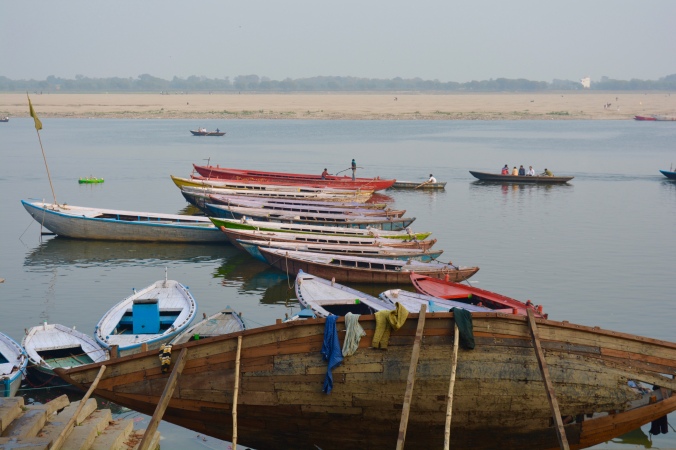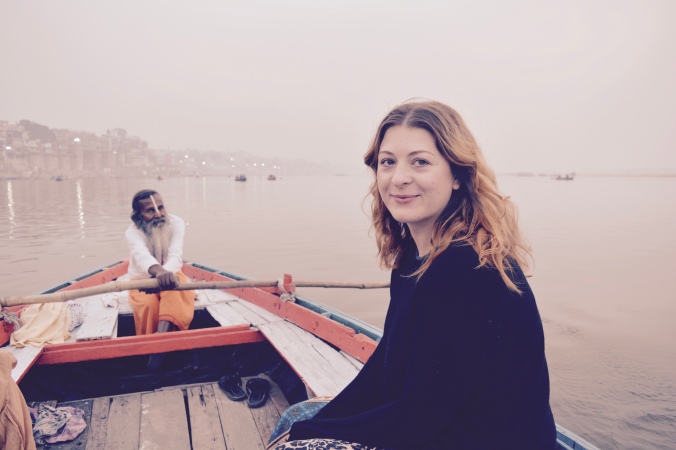I dreamt last night of fire and demons and death…
Varanasi is the holy capital of India. A supposed cultural and musical mecca and historically the place to go for fine, raw silk. I’d been drawn to it ever since watching a documentary years ago, fascinated by the openness of the cremations on the bank of the Ganges.
We arrived early. The sun was creeping through a hazy sky. Our Tuk-Tuk dropped us at an entrance to a maze of tiny streets. “Your hotel is that way” he points in a vague direction. Hannah felt like we’d been hustled. She was probably right.
We amble past shopkeepers, cows and shit. A queue for a temple is forming. Iron faced guards stand either side of a metal detector. The smell of manure and piss is overwhelming.
We arrive at Hotel Alka and now the sun has broken through the haze. Welcomed onto the balcony for breakfast we are greeted with a truly breathtaking view. The River Ganges stretches out in front of use and arches round a corner off into the distance.


Mother Ganga
Almost everything in Varanasi revolves around the Ganges. Hindu pilgrims from all over the country make their way here to purify themselves in her waters, seek blessing from her tears or lay their dead to rest on her banks.
Looking down we can see a melee of activity below us. Groups of men (mostly men) submerge themselves and their sons. Baba’s, draped in orange, sun themselves on the many ghats. People gather to wash clothes and sheets. Hoards of boats ferry tourists and of course touts offer their wares.
We toy with the idea of taking a dip but horror stories of backpackers becoming ill from the polluted waters keep us away. There is a big campaign to clean the Ganges, make it safe. After just recovering from various bouts of illness, we’ll keep dry for now.
At dawn the next morning we take a boat ride. A man in his sixties, white beard, grin all teeth and nails gets behind the oars.
He hollers out the names of famous ghats we pass but we’re unable to converse much further. We’re happy to watch. A swarm of seagulls attacks.
He rows us to the far end, one of the “burning ghats”. We see piles of smouldering ashes. People huddled in groups and teenagers gathering and distributing wood. We row on.


Temples and Silk
As we’re only in the city for 3 days we decide to invest in some local knowledge. We purchase a city tour from our hotel. The first guided tour of our trip and a wise move.
Our guide arrives after breakfast. Abu is a young man at 24 but his steely glaze and confident swagger make him appear older. He instantly puts us at ease as we walk through the maze of Old Town giving context to the unknown.
“He will dry it and sell it for houses to burn in the kitchens” he says as we pass a man shovelling cow shit into a plastic container with his bare hands. Aaah…I see now.
We emerge from the maze and jump in a car. The main part of our tour consists of visiting some of the roughly 33,000 temples that exist here.
Our driver navigates the mess of traffic on the road. The usual spray of horns envelopes us. Abu thinks its a real problem.
We pass a baba standing in the middle of the road semi naked except a tiny loincloth. His body is covered in white paint and his hair is matted and dreadlocked. He stretches out a plate with change. We drive on.
We jump from temple to temple. Along the way Abush gives us a crash course in Hinduism. Shiva (the destroyer) Vishnu (the preserver) and Brahma (the creator). Our first stop is the spacious and serene Banares Hindu University.
Our heads are full as we leave. This was worth it. Our next stop is Monkey Temple.
It’s Tuesday which is the day dedicated to Hanuman (Monkey god). The difference is vast. The building is more worn and used but there is life here.
Rhythm and chanting emulate from the heart. Worshippers rub paint on the walls and throw their arms to the sky. The heat and energy is raw. Orange and red.
We’re offered some sweets made from the temple bakery. Crumbled biscuit with butter and sugar. Its delicious!
We leave energised through gangs of fighting monkeys on our way to Durga Temple devoted to the Goddess of Power.
As you’d expect there are more women here. It makes a very welcomed change and Hannah understandably feels more at ease here. We both do. The inner building is a mass of red with a long queue looking to be blessed and pay their respects.
There are flowers and peacock feathers everywhere. Abush would tell us that the flowers are recycled to make coloured powders for art and festivals. He’s proud of the Hindu attitude to recycling and keeping the earth clean. A contradiction to our experience at large.
We finish our tour with a visit to a silk emporium in Old Town. Abush directs us into a small room off a back street. A small old man stretches out an arm and welcomes us with a grin.
Arun has been working in the silk trade in Varanasi for decades. He assures us that we are there to learn and look. No pressure to buy.
A young American couple enter the room and sit with us on the cushioned floor. They look as puzzled as we are. Arun sends out for Chai.
He gives us a history lesson about the silk trade in the area. Booming until recently when the tourist shops started selling cheap, plastic knock offs for cheap knock off prices. His is the real deal he assures us and takes a match to some thread. “Silk turns to ash. A fake will melt like plastic” he beams as he crumbles ash between his fingers.
Producing a box of quality saris he displays them all peacock for us. Maroon, orange, magenta, deep purple, black, mixes of silver, intwining patterns snap in our faces as he flicks them across the room. They all mesh on the floor. He pushes the quality again.
We leave dizzy having purchased two silk scarves and feeling like we got a bargain. The Americans bought a high end sari. Hats off to him.


Burning bodies and flying kites
Without a doubt the most powerful element of Varanasi is the burning ghats. One either side of our hotel, they never stop. Men (and only men) make the journey with their dead, dress them in the streets behind the river and carry them aloft to the bank.
Different levels (we are told that they represent the caste credentials) with wooden structures to support the weight.
Holy men conduct the service and the family members lift the bodies onto the structure and fire. All in the view of anyone who is watching.
We sat one night and took everything in. We felt like intruders peeking through the window of a special event. Uninvited.
But no one paid us attention. We were not who they were there for.
A man bursts out in tears as someone he knew, someone he loved is enveloped in flames. A sacred cow looming in the foreground. The scene becomes more real, more heavy.
We didn’t speak as we sat there in the blackness. Just watched, felt and cried . Our minds trying desperately to make some sort of connection between this and how we honour the dead back home. We were at a loss.
Hannah said it best. “I need some time to process this”.
The following evening and our last day in the city we stare once more from our balcony into the fading river.
Above our heads dozens and dozens of kites fly high. Some as much as 200 metres. The kites are a simple design. Craft paper and sticks attached to fishing line. All colours and no tail.
They dip and dive and attack as the sun sinks. The city seems romantic now. A complete contrast to what we saw the previous day.
We reflect on our time and both of us have questions about what we saw. There are no answers, or maybe they will come. Ultimately though we feel lucky to have been in such a special place that has shown us a different way to live and to die.


